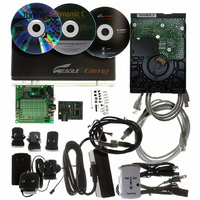101-1218 Rabbit Semiconductor, 101-1218 Datasheet - Page 26

101-1218
Manufacturer Part Number
101-1218
Description
KIT APPLCTN RABBITCORE RCM4010
Manufacturer
Rabbit Semiconductor
Series
RabbitCore®r
Datasheet
1.20-101-1094.pdf
(130 pages)
Specifications of 101-1218
Main Purpose
*
Embedded
*
Utilized Ic / Part
RCM4010
Primary Attributes
*
Secondary Attributes
*
Processor To Be Evaluated
Rabbit 4000
Interface Type
Ethernet
Operating Supply Voltage
12 V
Lead Free Status / RoHS Status
Not applicable / Not applicable
Other names
316-1156
- Current page: 26 of 130
- Download datasheet (809Kb)
3.2.2 Serial Communication
The following sample programs are found in the
•
•
•
20
FLOWCONTROL.C
CTS/RTS with serial data coming from Serial Port C (TxC) at 115,200 bps. The serial
data received are displayed in the
To set up the Prototyping Board, you will need to tie TxD and RxD
together on the RS-232 header at J4, and you will also tie TxC and
RxC together using the jumpers supplied in the Development Kit as
shown in the diagram.
A repeating triangular pattern should print out in the
The program will periodically switch flow control on or off to demonstrate the effect of
no flow control.
If you have two Prototyping Boards with modules, run this sample program on the
sending board, then disconnect the programming cable and reset the sending board so
that the module is operating in the Run mode. Connect TxC, TxD, and GND on the
sending board to RxC, RxD, and GND on the other board, then, with the programming
cable attached to the other module, run the sample program.
PARITY.C
repeatedly sending byte values 0–127 from Serial Port C to Serial Port D.
The program will switch between generating parity or not on Serial
Port C. Serial Port D will always be checking parity, so parity errors
should occur during every other sequence.
To set up the Prototyping Board, you will need to tie TxC and RxD together on the
RS-232 header at J4 using one of the jumpers supplied in the Development Kit as
shown in the diagram.
The Dynamic C
SERDMA.C
buffer to the serial port and vice versa. The Dynamic C
or clear the buffer.
Before you compile and run the sample program, you
will need to connect the RS-232 header at J4 to your
PC as shown in the diagram using the serial to DB9
cable supplied in the Development Kit.
Once you have compiled and run the sample program,
start Tera Term or another terminal emulation program to
connect to the PC serial port using a baud rate of 115,200
bps. You can observe the output in the
window as you type in Tera Term, and you can also
use the Dynamic C
The Tera Term serial utility can be downloaded from
hp.vector.co.jp/authors/VA002416/teraterm.html.
—This program demonstrates the use of parity modes by
—This program demonstrates using DMA to transfer data from the circular
STDIO
—This program demonstrates how to configure Serial Port D for
STDIO
window will display the error sequence.
window to clear the buffer.
STDIO
Dynamic C
window.
SAMPLES\RCM4000\SERIAL
STDIO
STDIO
STDIO
window.
window is used to view
RabbitCore RCM4000
folder.
Related parts for 101-1218
Image
Part Number
Description
Manufacturer
Datasheet
Request
R

Part Number:
Description:
COMPUTER SNGLBD BL2120 FRCTNLOCK
Manufacturer:
Rabbit Semiconductor
Datasheet:

Part Number:
Description:
KIT MESH NETWORK ADD-ON RCM4510W
Manufacturer:
Rabbit Semiconductor
Datasheet:

Part Number:
Description:
KIT DEV FOR BL2500 COYOTE
Manufacturer:
Rabbit Semiconductor
Datasheet:

Part Number:
Description:
KIT APPLICATION SIMPLE SENSOR
Manufacturer:
Rabbit Semiconductor
Datasheet:

Part Number:
Description:
KIT ETHERNET INT'L RCM3720
Manufacturer:
Rabbit Semiconductor
Datasheet:

Part Number:
Description:
KIT SERIAL-ETHERNET APPLICATION
Manufacturer:
Rabbit Semiconductor

Part Number:
Description:
KIT APPLICATION MULTI-PORT S2E
Manufacturer:
Rabbit Semiconductor

Part Number:
Description:
KIT WEB SECURE EMBEDDED RCM3700
Manufacturer:
Rabbit Semiconductor
Datasheet:

Part Number:
Description:
MODULE RABBITCORE RCM3720
Manufacturer:
Rabbit Semiconductor
Datasheet:

Part Number:
Description:
MODULE RABBITCORE RCM3220
Manufacturer:
Rabbit Semiconductor
Datasheet:

Part Number:
Description:
MODULE RABBITCORE RCM3210
Manufacturer:
Rabbit Semiconductor
Datasheet:

Part Number:
Description:
COMPUTER SGL-BOARD OP6600 W/SRAM
Manufacturer:
Rabbit Semiconductor
Datasheet:

Part Number:
Description:
COMPUTER SGL-BD BL2000 SRAM/FLSH
Manufacturer:
Rabbit Semiconductor










